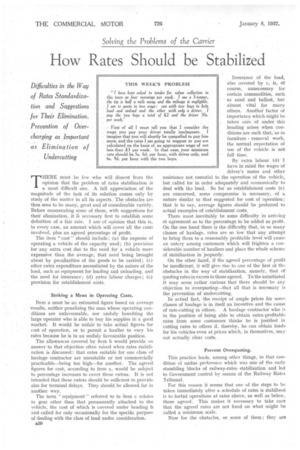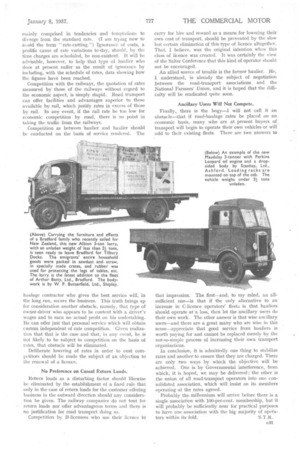How Rates Should be Stabilized
Page 44

Page 45

If you've noticed an error in this article please click here to report it so we can fix it.
HERE must be few who will dissent from the opinion that the problem of rates stabilization is a most difficult one. A full appreciation of the magnitude of the task of its solution comes only by study of the matter in all its aspects. The obstacles are then seen to be many, great and of considerable variety. . Before enumerating some of them, with suggestions for their elimination,. it A necessary first to establish some definition of a fair rate. I am of opinion that this is, in every case, an amount which will cover all the costs involved, plus an agreed percentage of profit.
The item •" cost " should include : (a) the expense of operating a vehicle of the capacity used; (b) provision for any extra cost due to the need for a vehicle more expensive than the average, that need being brought 'about by peculiarities of the goods to be carried; (c) other extra expenditure necessitated by the nature of the load, such as equipment for loading and unloading, and the need for insurance; (d) extra labour charges ; (e) provision for establishment costs.
Striking a Mean in Operating Costs.
Item a must be an estimated figure based on average -results, neither penalizing the man whose operating conditions are unfavourable, nor unduly benefiting the large operator who is able to buy his supplies in a good market. It would be unfair to take actual figures for cost of operation, or to permit a haulier to vary his rates because he is in an unduly favourable position.
The allowances covered by item b would provide an answer to that objection often raised when rates stabilization is discussed: that rates suitable for one class of haulage contractor are unsuitable or not commercially practicable—being too high—for another. The agreed figures for cost, according to item a, would be subject to percentage increases to cover these extras, It is not intended that these extras should be sufficient to provide also for terminal delays. They should be allowed for in another way.
The term " equipment " referred to in item c relates to gear other than that permanently attached to the vehicle, the cost of which is covered under heading b and called for only occasionally for the specific purpose of dealing with the class of load under consideration.
1330
assistance not essential to the operation of the vehicle, but called for in order adequately and economically to deal with the load. So far as establishment costs (e) are concerned, some compromise is necessary, of a nature similar to that suggested for cost of operation; that is to say, average figures should be preferred to actual examples of establishment costs.
There must inevitably be some difficulty in arriving at agreement as to the percentage to be added as profit. On the one hand there is the difficulty that, in so many classes of haulage, rates are so low that any attempt to bring them to a reasonably profitable level will cause an outcry among customers which will frighten a considerable number of hauliers and place the whole scheme of stabilization in jeopardy.
On the other hand, if the agreed percentage of profit be insufficient, it will give rise to one of the first of the obstacles in the way of stabilization, namely, that Of quoting rates in excess to those agreed. To the uninitiated it may seem rather curious that there should be any objection to oyerquoting—that all that is necessary is the prevention of Undercutting.
In actual fact, the receipt of ample prices for some classes of haulage is in itself an incentive and the cause of rate-cutting in others. A haulage contractor who is in the position of being able to obtain extra-profitable rates from some customers thinks he is justified in cutting rates to others if, thereby, he can obtain loads for his vehicles even at prices which, in themselves, may not actually clear costs. .
Prevent Overquoting.
This practice leads, among other things, to that condition of undue preference which was one of the early stumbling blocks of railway-rates stabilization and led to Government control by means of the Railway Rates Tribunal.
For this reason it seems that one of the steps to be taken immediately after a schedule of rates is stabilized is to forbid operations at rates above, as well as below, those agreed. This makes it necessary to take care that the agreed rates are not fixed on what might be called a minimum scale.
Now for the obstacles, or some of them ; they are
mainly comprised in tendencies and temptations to diverge from the standard rate. (I am frying now to avoid the term "rate-cutting.") Ignorance of costs, a prolific cause of rate variations to-day, should, by the time charges are schedUled, be non-existent. It will be advisable, however, to: help that type of hardier who does at present suffer as the, result of ignorance by including, with the schedule of rates, data showing how the figures have been reached.
Competition with the railways, the quotation of rates measured by those of the railways without regard to the economic aspect, is simply stupid. Road transport can offer facilities and advantages superior to those available by rail, which justify rates in excess of those by rail. In any event, if the rail rate be too low for economic competition by road, there is no point in taking the traffic from the railways.
Competition as between haulier and haulier should . be conducted on the basis of service rendered. The haulage contractor who gives the best service will, in the long run, secure the business. This truth brings up for consideration another obstacle, namely, that type of owner-driver who appears to be content with a driver's wages and to earn no actual profit on his undertaking. He can offer just that personal service which will obtain custom independent of rate competition. Given realization that that is the case and that, in any event, he is not likely to be subject to competition on the basis of rates, that obstacle will be eliminated.
Deliberate lowering of rates in order to oust competitors should be made the subject of an objection to the renewal of a licence.
No Preference on Casual Return Loads.
Return loads as a disturbing factor should likewise be eliminated by the establishment of a fixed rule that only in the case of return loads for the customer offering business in the outward direction should any consideration be given. The railway companies do not tout for return loads nor offer advantageous terms and there is no justification for road transport doing so.
Competition by B-licensees who use their licence to carry for hire and reward as a means for lowering their own cost of transport, should be prevented by the slow but certain elimination of this type of licence altogether. That, I believe, was the original intention when this class of licence was created. It was certainly the view of the Salter Conference that this kind of operator should not be encouraged.
An allied source of trouble is the farmer haulier. He, I understand, is already the subject of negotiation between the road-transport associations and the National Farmers' Union, and it is hoped that the difficulty will be eradicated quite soon.
Ancillary Users Will Not Compete.
Finally, there is the bogy—I will not call it an obstacle—that if road-haulage rates be placed on an economic basis, many who are at present buyers of transport Will begin to operate their own vehicles or will add to their existing fleets. There are two answers to that impression. The first—and, to my mind, an allsufficient one—is that if the only alternative to an increase in C-licence operators' fleet.; is that hauliers should operate at 'a loss, then let the ancillary users do their own work. The other answer is that wise ancillary users—and there are a great many who are wise in this sense—appreciate that good service from, hauliers is worth paying for and cannot be replaced merely by the not-so-simple process of increasing their own transport organizations.
In conclusion, it is admittedly one thing to stabilize rates and another to ensure that they are charged. There are only two ways by which the objective will be achieved. One is by Governmental interference, from which, it is hoped, we may be delivered:' the other is the union of all road-transport operators into one consolidated association, which will insist on its members operating at the rates agreed.
Probably the millennium will arrive before there is a single association with 100-per-cent. membership, but it will probably be Sufficiently near for practical purposes to have one association with the big majority of operators within its fold.S.T.R.




























































































